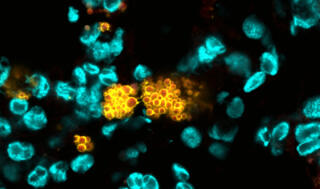Lipid droplets engineered for the production of terpenoids in plant leaves

Anchoring of biosynthetic enzymes onto the lipid droplet surface results in enhanced terpenoid production and sequestration.
The Science
Terpenoids represent a broad class of naturally-produced, high-value products with multiple applications including potential use as biofuels. Biological production of terpenoids at high titers is limited by flux of metabolic precursors into engineered biosynthetic pathways and toxicity of accumulated bioproduct. Researchers targeted biosynthetic enzymes to specialized organelles called lipid droplets resulting in high terpenoid content in plant vegetative tissue.
The Impact
Targeting of biosynthetic enzymes to lipid droplets opens up new avenues for synthetic biology and enhances biological terpenoid production through entrapment within a specialized cellular compartment. Application of the lipid droplet engineering approach to stably transformed biomass crops would represent a significant breakthrough in the production of terpenoids as biofuels or co-products on an industrial scale.
Summary
Terpenoids are high-value compounds with a wide range of industrial uses. However, large-scale economical production is challenging. For example, several plants naturally produce terpenoids, but at low levels – and extraction and purification of these compounds is costly. In a new study, researchers from Great Lakes Bioenergy Research Center and DOE’s Plant Research Laboratory utilized lipid droplets (LDs) in plants as a vehicle for enhanced terpenoid production and accumulation in plant leaves. LDs are cytoplasmic organelles composed of a hydrophobic core of triacylglycerol surrounded by a phospholipid monolayer and coated with LD-associated proteins. LD production was enhanced in the transient Nicotiana benthamiana system through ectopic expression of WRINKLED1, encoding a key regulator of plastid fatty acid biosynthesis, and a gene encoding a microalgal LD surface protein. Novel combinations of terpenoid biosynthetic enzymes, produced within the cytosol or plastid, boosted production of terpenoid building blocks and target terpenoids. Due to their hydrophobic properties, terpenoids were able to be trapped within the LDs, which act as a reservoir that facilitates terpenoid recovery from plant leaves. Finally, anchoring of distinct biosynthetic enzymes onto the surface of LDs leads to efficient production of terpenoid scaffolds and functionalized terpenoids. The described synthetic biology approach could enable specific spatial arrangements or compartmentalization of enzymes, bringing them into closer proximity and creating multi-enzyme assemblies within LDs. Importantly, implementation of the technology within bioenergy crops would represent a significant breakthrough in the production of terpenoid biofuels and bioproducts on an industrial scale.
Program Manager
N. Kent Peters
Program Manager, Office of Biological and Environmental Research
kent.peters@science.doe.gov, 301-903-5549
Corresponding Authors
Bjoern Hamberger
Michigan State University
hamberge@msu.edu
Christoph Benning
Michigan State University
benning@msu.edu
Funding
This work was primarily supported by the U.S. Department of Energy, Office of Science, Office of Biological and Environmental Research under award number DE-FC02-07ER64494 and DE-SC0018409. Additional funding was provided by the Division of Chemical Sciences, Geosciences and Biosciences, Office of Basic Energy Sciences, U.S. Department of Energy award number DE-DE-FG02-91ER20021 and by AgBioResearch, Michigan State University (MICL02357 and MICL02454).
Publications
R. Sadre, P. Kuo, J. Chen, Y. Yang, A. Banerjee, C. Benning, and B. Hamberger, “Cytosolic lipid droplets as engineered organelles for production and accumulation of terpenoid biomaterials in leaves.” Nature Communications 10, 853 (2019). DOI:10.1038/s41467-019-08515-4.
Related Links
https://www.glbrc.org/news/researchers-engineer-plant-oils-make-and-sto…
https://msutoday.msu.edu/news/2019/harnessing-synthetic-biology-to-prod…